The School on the Hill: 125th Anniversary of ODSS
As Orangeville District Secondary School celebrates its 125th anniversary, a teacher looks back fondly at the storied past of the region’s first high school.
The night of Sunday, February 1, 1948 was bitterly cold in Orangeville as a stiff westerly wind whipped the flames at the corner of Faulkner and Fead into an inferno. The Orangeville High School was on fire.
Desperately the fire brigade and community volunteers fought to control the smoke and flames shooting from the roof. But the building was too tall and a thick sheath of ice encased the fire hoses attached to a single hydrant. Unnerving explosions added to the intensity, as ammunition stored for the cadet corps and the contents of the chemistry classroom ignited.
By morning, all that remained of the proud “school on the hill” was a two-room annex and the gymnasium.
The sixty-four-year-old building, once considered state of the art, was gone, but the spirit of its staff and students remained intact. Within hours the board of education and teachers were cobbling together a makeshift school. Staff had managed to remove band instruments, the office typewriter and adding machine, along with steel cabinets containing precious school records. On the bleak days following, a few more items were salvaged.
“Even now, something will trigger the smell of that smoke on books and on my hands,” says Jean (Dodds) Thompson, the first, and for many years, only, secretary of the school.
Although plans had been underway for some time to build a new school for the growing community, classroom space was suddenly needed urgently for nearly 200 students. Soon grade nine students were assigned to a hall above Patterson’s Furniture, grade ten to the Pentecostal Church, grade twelve to Tweedsmuir, and grades eleven and thirteen to Westminster United.
Teachers trudged from building to building through the snow to instruct their classes. Retired vice-principal Verd Yates, now 91, recalls being given a tour of his new “classroom” when he was hired in 1949:
“I didn’t understand – all of a sudden we were entering the church across from St. Mark’s. I didn’t know whether I was going to get blessed or not! I was quite taken aback – I had no inkling the old school had burned down.” Despite his initial misgivings, Yates says, “I signed on with a group of excellent people who stood together during that difficult year and the transition to a new building.”
Throughout that challenging period, principal Maurice Cline kept students on course. “There is no pleasure in a job half-done,” he declared. “The only real lasting joy…in our school life is in doing our daily tasks well.”
At the eventual opening of the new high school in 1951, English teacher Marjorie Kidd reflected, “The difficulties of the past three years have made us especially appreciative of our new school. In spite of the kindnesses of the various churches who offered us space and the school boards who offered equipment, it was a difficult period, working without proper facilities, in cold and discomfort. We are proud that our students faced the challenges of these difficulties – that co-operation and scholastic standards have been high in spite of the hardships.”
The ideals and traditions of the old school on the hill were symbolized by two commemorative slabs saved from the original building. As Principal Cline noted, “It is generally agreed that the highest ideal of a secondary school is not merely the dissemination of factual information, but the moulding of character and the shaping of good citizens.”
Such high-minded values had been instilled in 1884 at the opening of the Orangeville High School. Its construction had been strongly recommended two years earlier by school inspector Nathaniel Gordon: “It is not becoming for a town with such possibilities not to have a high school.”
Until that time, students had attended the Orangeville Grammar School, occupying two rooms of the old Orangeville Public School on Zina Street. However, the new site was controversial. Many citizens criticized its location at Faulkner and Fead as “too out of the way” and “awkward to reach” at the top of a steep incline. Yet, as the first high school to be built between Brampton and Owen Sound, it also showcased Dufferin’s recently acquired status as a county in style.
Alexander Steele, the first principal, “was loved and respected,” according to Ernest Dodds, who wrote The History of Education in Dufferin County (1983). He was also “instrumental in starting the library and a perfectionist in teaching mathematics.” A brilliant scholar in his own right, Steele was a gold medallist at the University of Toronto in English, mathematics and philosophy, and proficient in six languages.
Throughout Steele’s tenure and that of his successor, Edward Hackett (1915-1941), the modestsized school established an outstanding record of academic excellence and community service.
Students from the earliest years include doctors Minerva (1887) and Hannah (1891) Reid, sisters who were key players in founding Women’s College Hospital; Robert Gunn Bremnar (189?), a United States senator and advisor to President Woodrow Wilson; and Dr. George Campbell (1898), winner of an Olympic gold medal for lacrosse (1908) and later co-founder of several Orangeville institutions, including the curling club. (On that fateful February night in 1948, Dr. Campbell was spotted at the top of a ladder wielding a fire hose.)
Maurice Cline became the principal of OHS in 1941 and soon claimed a leading role in many of the school’s most colourful stories. Clare McCarthy, a local writer and former math department head, paints a vivid picture of the literally larger-than-life character in a six-foot-four frame anchored by size twelve Dacks: “The clickers on his heels served as his built-in early warning system. As he patrolled the cavernous high school halls, his distinctive Clydesdale-like clip-clop [would make sure] you had plenty of time to appear the picture of innocence by the time he arrived.”
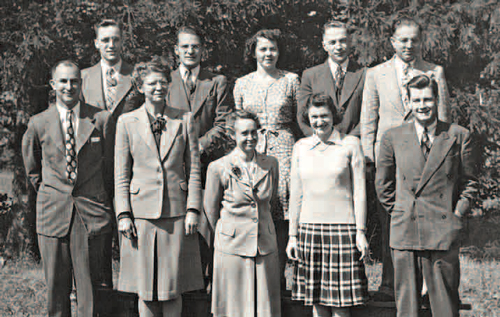
OHS staff, 1947. Back, left to right : Gordon Gibson, Claude Kalbfleisch, Jean Dodds, Andrew Percy and John Hamilton. front, left to right : Maurice Cline, Marjorie Kidd, Elizabeth McPhedran, Edith Lyons and Robert Laughlin.
McCarthy portrays Cline, nicknamed “Morris,” as a “people person” and hands-on administrator. School secretary Jean Thompson adds that he “demanded respect for staff and each other, and absolutely did not tolerate bullying. Skipping [classes] was also taboo. He would phone the pool room downtown to see if the students were there, and I was sent down to get them.”
Cline’s “ounce of prevention” included invitations to his home to play on his pool table instead. Dr. Allan Marshall (1944) remembers, “We would show up with our girlfriends on Friday nights and always enjoyed ourselves.”
Cline’s heart seems to have more than matched his physical size. Murray Young, a retired environmental science teacher, now in his eighties, recalls a phrase that Cline often repeated to his staff and students: “Don’t be afraid to go the second mile. If you’re prepared to do the work, I’m prepared to support you.”
Retired social science head John Handy says Cline’s empathy with students carried over into the “student centred” philosophy of the school – well before that phrase became an educational buzzword. “We were ahead of the curve,” he says.
In the era before buses, rural students had difficulty making their way to town because many roads were closed during Dufferin’s harsh winters. Instead, many of them chose to board in town. Over the years, Cline and his wife Mary welcomed several into their home. Among them was Dr. John Russell (1944), who remembers, “I learned a lot about school, a lot about education and I learned to play pool. Mr. Cline was fair, but quite stern. He was a bit of a card in that he said you couldn’t get away with anything because he had done everything wrong when he was young, so he knew.”
Later, Morris collaborated with Jim Dods (then chair of the school board), Dr. Charles Scott and the Orangeville Rotary Club to establish the Student Aid Corporation, a source of interestfree loans for university tuition. Dods was also influential in implementing free textbooks and, at last, busing in Dufferin. In these initiatives, Cline and his colleagues actively practised the educational motto, in loco parentis (in place of a parent).
As Verd Yates observes, “The odd time, if we felt that the student was not getting the support at home that they needed, if we could make up for that as a staff, I think we were doing our job.”
It was not just students who benefitted from Cline’s generosity. He had even been known to spend the occasional summer building houses nearby for his new teachers and their young families as encouragement to stay in the community long term. More than fifty years later, Murray Young and his wife still reside in the home built for them by his principal and a fellow teacher, Gord Gibson.
Cline had a powerful ally in his “fair but firm” approach in the person of Elizabeth McPhedran, a Latin and home economics teacher and a legend in her own right. A diminutive, no-nonsense taskmistress, “Phedie” demanded a high level of performance from her students, but also garnered their affection and respect.
Among McPhedran’s prized possessions was a wartime letter from former student Ray Walker, then stationed on the European front: “I guess we were the despair of more than yourself in those days and herewith is a belated message of thanks for the interest you and many other teachers took for our well-being. You did a good job in equipping us … on the various paths of life leading from the old school on the hill.”
Together, school staff and the progressive board led by Dods celebrated the opening of the new Orangeville District High School – described unflatteringly by one commentator as “a one-storey sprawling mass” – on October 2, 1951. In 1964, there was a major expansion with the addition of the technical and business wings. In the late sixties, the “800 hall” and the cafetorium were added.
One of the features of the new school would raise eyebrows by today’s standards. “The war had only been over for a few years and you might be surprised that the plans included a shooting gallery in the basement,” says Verd Yates. “The cadet movement was very strong throughout Ontario and most high schools had a cadet corps … and some of those students became good marksmen. In fact, sometimes we competed as to who would buy the milkshakes after school.”
Administrative assistant Kathy (Keating) Hunt (1976) recalls that even in the seventies and eighties, “Kids were walking up the halls to put their guns in the vault. They would get their ammunition from the office.”
The mysterious “tunnel” (part of the maintenance system) beneath the school has also been a source of fascination for students over the years. The rumour persists that it contained an emergency electrical generator during the Cold War.
Another legend has it that a moaning “ghost” emerged from the tunnel in the middle of a Latin class, which was hastily abandoned. Hunt also recalls, “You’d be sitting in math class in the 100 hall and, all of a sudden, the trap door would open and a textbook would fly out because the custodians would be down there and find whatever we had hidden in the hole.” Current students who have heard such stories from their parents are still intrigued by “what lies below.”
One outstanding feature of the school is its greenhouse, the jewel of an innovative environmental science program pioneered by Murray Young and now being rejuvenated by geography/ history department head and organic gardener Jamie Richards. Young also still takes pride in the fact that he and his students “seeded every blade of grass and planted every tree” on the school grounds.
Not all was sweetly pastoral, however. Jean Thompson recalls ruefully, “In the spring when Murray’s chickens hatched down in the science room, the smell was overwhelming. You’d have all the doors and windows open. Finally, Miss McPhedran read the riot act – either Murray went or the chickens went.” He stayed.
In spite of the chicken controversy, Young now reflects, “I was fortunate to be at Orangeville Secondary School in what for me were ‘golden years.’ I didn’t realize at the time what a tremendous responsibility we teachers had. When I was talking about conserving Canada’s natural resources, little did I realize that our greatest natural resource was sitting right in front of me – a ‘brain bank,’ in fact. Now, looking back over fifty years, it’s awe-inspiring. In fact, you feel kind of humble to have had that opportunity to shepherd these people, guide their thinking and encourage them.”
Many of the members of that “brain bank,” from current and past generations, will be formally acknowledged this fall when the school’s Wall of Fame is unveiled during the school’s 125th anniversary celebrations on October 3.
One of those students, Arnold Holmes (1958), says OHS prepared him very well for post-secondary education and his “unbelievable” career as the registrar at the University of Guelph. “I’m so grateful for people like Murray Young and Morris Cline. Murray gave us a test on the first day about the counties of Ontario with their capitals. Of course we all knew Dufferin, but we didn’t know the rest of the province. We all felt so terrible. But he made sure we knew it.”
Young cites several factors for the successes of the golden years: the school’s smaller size, its rural character, and the work ethic of students and their families – the result perhaps of a time when obtaining a postsecondary education was more of a rarity and often required great personal and financial sacrifice.
Another factor was the “personal touch” of school staff. Shirley Ann (McFee) Holmes (1958) observes that, “For me, it was a real eye-opener to have the personal support of my home economics teacher, Miss McPhedran. She recognized that I had skills that I didn’t even know there was a career for. She took me to MacDonald Institute in Guelph, where I enjoyed a wonderful career.”
Jean Thompson recalls that absent students would receive daily calls at home to help “keep them in tow.” In fact, she regularly introduced herself to one family as “your morning alarm clock calling.” Kathy Hunt adds, “The parents got to know our voices so we had rapport with them as well. It was a good community, the teachers stayed longer, we knew their names, we knew their wives’ names, we knew their kids’ names.”
In a pre-Facebook and pre-textmessaging era, the school was the social heart of the community where plays, concerts, sports events and the day-to-day routines of acquiring an education brought together diverse personalities and created lifelong friendships and shared memories.
“During my time there, I felt it was really a major part of the community,” says Verd Yates. “Orangeville was a growing town, the high school was a growing school, and I think they grew together.”
Today, little has changed physically in the modern incarnation of the school on the hill. However, since the opening of its sister school, Westside Secondary, in 1999, the halls are noticeably less crammed than when Rosanne Collis (1980), now a drama teacher, was a student. “We were really overcrowded. You could barely move between classes. If you were walking down the 100 hal l and dropped your pencil case, it was gone, because you couldn’t bend over to pick it up. It was like a herd of cattle moving down a chute.”
Cynthia Husband (1984) remembers being in the arena – “the school by the pool” – for grade nine, where she studied math and geography just off the pool balcony and science and language in the banquet hall. “I didn’t have to have classes in the skate change room, though,” she laughs.
With the school bulging at over 2,300 students, Lesley Loftus, Darryn Stevenson and Audra Cook, all 1992 grads and also now staff, were assigned shifts during which some students would have their official lunch period at 9 a.m.
Still, apart from less congestion, for Collis it is “déjà-vu every day – the school hasn’t changed at all. It still looks the same, and the weirdest part right now is that the clothes are exactly the same as when I was a student here in grade eleven in 1977.”
Retired history head and running coach Hal Babcock notes, “We’ve had a large number of passionate and committed students at ODSS and they in turn fed us as teachers. And many of them have brought that passion and commitment back to this community.”
Science teachers Matt Burnside (1995) and Stuart Dennie (1996) are among those who have come back. Both credit their high school experience as influential in their decisions to become teachers themselves. Says Burnside, “Because I was a student here, I have more pride in the school. This is my school as opposed to just another job.”
For Dennie, “It’s the whole idea of giving back what you got when you were here as a student. There were so many great teachers and classmates who influenced me when I was here and I want to make sure that continues. I like that my own son will be a student here too.”
At the 1983-4 class reunion this past July, several alumni shared their own memories: Dave Holden enthused about the standing-room-only talent shows on the last day of school; Paul Preston reminisced about the terrific bands, such as Anvil and Max Webster (and later, Blue Rodeo, Bare Naked Ladies and Sloan), that performed at school dances; Jude and Lisa (Barber) DeCastro, high-school sweethearts “still together after all these years,” were proud that their daughter Kristen is the student council president for the class of 2009; Cynthia Husband and Gregg Loane fondly recalled the yearbook class, canoe trips and, yes, rifle practice.
Asked what he remembered most about his high school years, Kevin Dueck seemed to sum up it up for everyone: “Friendship, camaraderie, a sense of belonging, a sense of family. I don’t think we really realized it at the time. Unfortunately, it took us twenty-five years to understand what we had then.”
Leslie Godfrey is the teacher-librarian at Orangeville District Secondary School. Wanting to throw an enormous party before she retires in June 2010, she agreed to chair the 125th Anniversary Celebration. She thanks her principal Darryl Kirkland for the opportunity.
Wall of Honour
Inspired by the rich legacy of achievement at ODSS, staff and students have created a Wall of Honour in the school’s foyer to recognize alumni who have excelled in their chosen fields and/or made significant contributions to society. During the anniversary celebrations on October 3, more than 150 people will be inducted in the categories of Athleticism, Brilliance, Compassion and Citizenship, Courage, Creativity and Entrepreneurial Spirit.
Some of these include:
Athleticism
Dr. George Campbell, Al Pilcher, Bernadette (Casey) Bowyer, Ron Howden, Dr. Lee-Anne Laverty, Michelle (McKendry) Ruthven, Kevin Stittle, Keith Beavers and Sarah Bonikowsky (Olympic athletes); Jeff Ellis (Ontario’s most decorated high school athlete to date); Lisa Patterson (cross-country skier); Bryon Mackie (boxer); Adam ‘Edge’ Copeland and Jason ‘Christian Cage’ Reso (wrestlers), and many local lacrosse stars, including the well-known Sanderson family.
Brilliance
Drs. Hannah and Minerva Reid (Women’s College Hospital); Dr. Bernadette Garvey and Jennifer Juno (AIDS researchers); Alan Rayburn (geographer and historian); Dr. William Waters (Professor Emeritus, Rotman School of Management) and Dr. Bill Leggett (Principal Emeritus and Professor Emeritus of Biology, Queen’s University).
Compassion and Citizenship
C.I. Scott and Dr. David Scott; Barry Woodyard; Bill Parke; Ross Martin and Tom, James and John Lockyer, all of whose contributions are too many and varied to list here.
Courage
Veterans of the First, Second and Korean wars, and Matthew McGrady McCully, killed in Afghanistan.
Creativity
Archibald Lampman (Confederation poet); Gerry “The Big Bear” Barrett (aboriginal stand-up comedian); William Vickers (actor, Shaw and Stratford Festivals); Maggie Collis, John Hill, Jon French and Ray Gieringer ( film animation and special effects); Jon Dueck (film and television producer); Stephen MacEachern and Shannon Cowan (illustrator and writer).
Entrepreneurial Spirit
Constance Ward Harper (who conceived and organized the first flag day in the world for Belgians in World War One); Mable Elizabeth Watson (the first woman to fly with the Canadian Air Mail); Bruce Dodds (President, Charterways Transportation) and David McCleary (President, Orangeville Bottling Company et al).
How would you like to be remembered
One of the mysteries of teaching is that often one isn’t aware at the time of how one might be perceived by students. In answer to the question how would you like to be remembered? Past and present ODSS educators responded with similar themes: personal connection, intellectual curiosity, enthusiasm, inclusion, broadened horizons, respect, encouragement and support:
Glenn Godfrey (Visual Arts)
I hope that students remember that we (he and Gary Cook) were able to have fun and a sense of humour while we loved our subject, worked hard and produced something worthwhile. We always emphasized “be yourself, be an individual’ and we’ll handle the fallout if necessary. And that produced some really exciting things and some very dynamic individuals who have gone on to excel.
Audra Cook (Vice-principal)
I’d like to be remembered as a caring and committed educator who was there for kids, through good times and bad. Even when I’m suspending a student, I want them to know it’s for the best, because we really want to mould them into responsible citizens.
Darryn Stevenson (Phys Ed)
I’d like to be remembered as a teacher who did lots of stuff with kids outside the classroom: canoe trips, hiking, tournaments – because sometimes you get an extremely different perspective about who that student is when you’re away from the school.
Hal Babcock (History)
I’m sure I was annoying for some students and not for others, but I’d like to think I was a catalyst for critical thinking.
Sharon Babcock (Family Studies)
I’d like to be remembered as a nurturer, as someone who helped kids grow and gave them what they needed at the time.
John Handy (Social Science)
You’d like to think you’ve done something for students. If you’ve just touched them a little bit and helped them along somehow, that’s enough – and I hope that happened. I tried to treat staff and students the way I wanted to be treated myself – with respect.
Gary Gravelle (English)
As well as dedicated and conscientious, I tried to be tolerant, fair, concerned and open-minded. I hope that’s what kids remember.
Lesley Loftus (History)
[Because we’ve grown up in a small town] I hope to create the desire in my students to see more and know more of the world but also to know that it’s okay to come back. We all did!
Gord McGiverin (Drama)
I hope students have had that experience of working together in a group with a common goal, not based on what fashion style you wear, or what music you listen to, that helps that student who hasn’t really found their niche as yet.
Michelle Grierson (Dance)
I hope that we’ve affected students intellectually and that kids are thinking about the world, that they’re not so self-absorbed, that they’re actually thinking about how they can positively help the world, questioning…and also that we affected their hearts. That’s what my teachers did for me…provoking thought, provoking people to a place of action and heartfelt emotion towards humanity.
Gary Cook (Visual Arts)
I just want to be remembered!

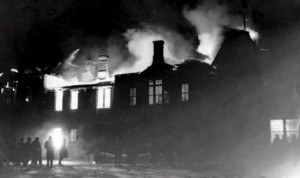
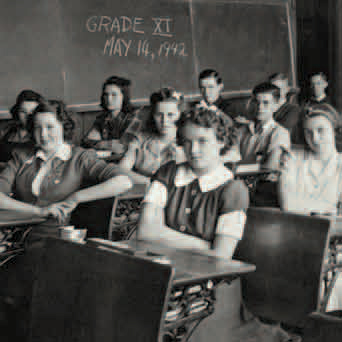
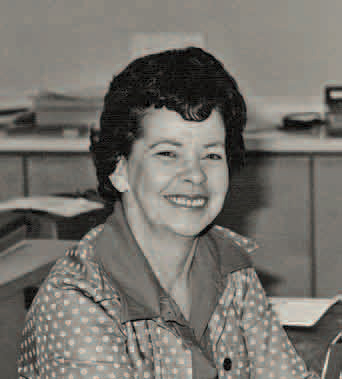
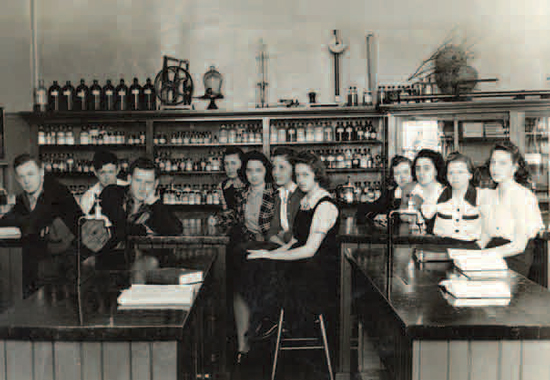
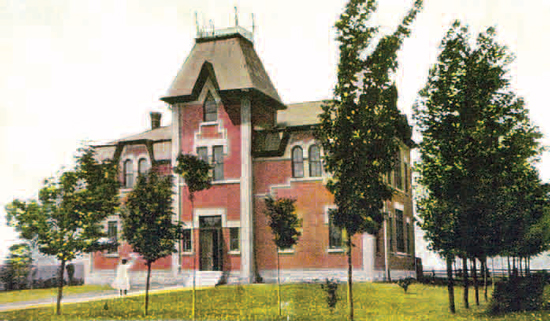
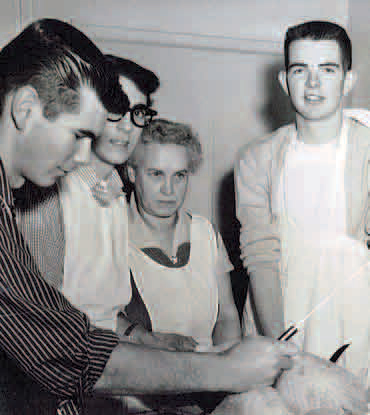
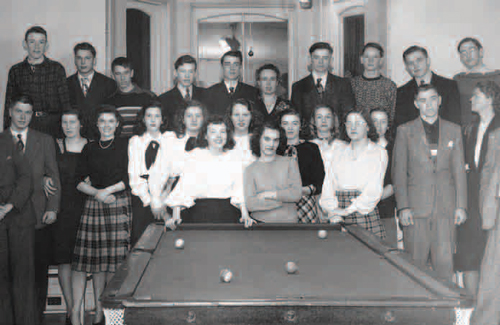






I was in the class in 1985, and Gary Gravelle, John Handy, Hal Babcock and especially the late Richard Pollard (where my love of science was fostered) are all remembered fondly!
Cheri (Cincinnati Ohio)
Cheri Monteith McMaster on Feb 1, 2022 at 9:24 am |
Cynthia Husband and Gregg Loane – I have fond memories of the year book trip to Northbay, Ontario! Wasn’t that a great week? Always wondered what happened to you both.
Melody Anderson from Winnipeg on Oct 2, 2015 at 6:25 pm |
Wow! I wish someone would please inform me if there are any ODHS reunions in future. Last I heard of one was in the 1970’s and could not attend!
So sad I missed the last. We are not getting younger!
SO many Great! ODHS memories
Barbara Still Ray from waterloo ontario on Jul 12, 2015 at 8:51 pm |
Does anyone know where I can get a copy of the back cover of the 1962 year book? I drew the cartoon on the back captioned ” The End “. I was in the 9th grade. My name was Janna (Janny) Spanninga.
Janna Douma from Waterdown Ontario on Dec 21, 2014 at 10:50 pm |
It was wonderful to read the article about this amazing school, rich in history thanks to many who walked it’s halls. For many of small town and rural kids, the expanse of the school was beyond belief and one inevitably had a class in the 800 hall followed by one at the furtherst end of the 100.
I was so happy to see comments by many of the teachers who really did have an impact on my life and engrained the seeds of curiosity and strength to challenge and question. In particular, the dynamic art duo of Mr. Godfrey & Mr. Cook…I’m still painting and creating. Mr. Gravelle’s English classes definitely made me look at different genres with new eyes and Mr. Babcock’s grade 9 history classes in the room above the pool were alway lively.
Thanks to all, both staff and peer, who are the heart of ODSS!
Lori Skimin on Oct 2, 2009 at 10:31 pm |
Contrary to popular belief Phedie was not as popular as you think. She “played favourites” to the nth degree. Also, if she didn’t like your parents she didn’t like you !! Her “marking” skills sucked! The only students who got good marks in sewing were their garments she “herself sewed” used for demonstration purposes. I could go on and on and on. Personally, I have learned over the years that her home ec skills were not very good at all.
Cheryl Cronin
Cheryl Cronin on Sep 19, 2009 at 8:25 pm |
Congratulations,Lesley. You have organized a great party. ODSS deserves it. Being a teacher there for 33 years was a treasure. It was always a pleasure to go to work.The comments about Maurice Cline are so true. He was the heart and soul of the school.
The 1974 date can not be correct since I had been a teacher there for 7 years at that time and you know that I would not have missed the picture.
Enjoy the celebration. BettyAnnAsher(Kelly)1966-1999
BettyAnnAsher on Sep 16, 2009 at 6:10 pm |
Pat, Leslie and Betty Ann, thanks for highlighting the typo on the photo caption, which now reads 1947 NOT 1974. Thanks!
admin on Sep 16, 2009 at 9:39 pm |
Just received “In The Hills” and began by reading this delightful article on my old High School. However I believe there is a mistake in the caption of the picture of OHS Staff. I believe 1974 is an incorrect date. I attended in 1962 and there were 27 staff members in the yearbook picture. Mr. Cline, Mr. Percy, Mr. Gibson and Miss McPhedran all looked much older in my 1962 picture than they do in your 1974 picture.
Pat Walker on Sep 16, 2009 at 2:46 pm |
Thanks for your comment Pat. And thanks for the heads up re: the photo dates. We’ll look into it.
admin on Sep 16, 2009 at 2:54 pm |
Hi. The date of the staff photo was actually 1947 – just a typo…
Leslie Godfrey on Sep 16, 2009 at 4:43 pm